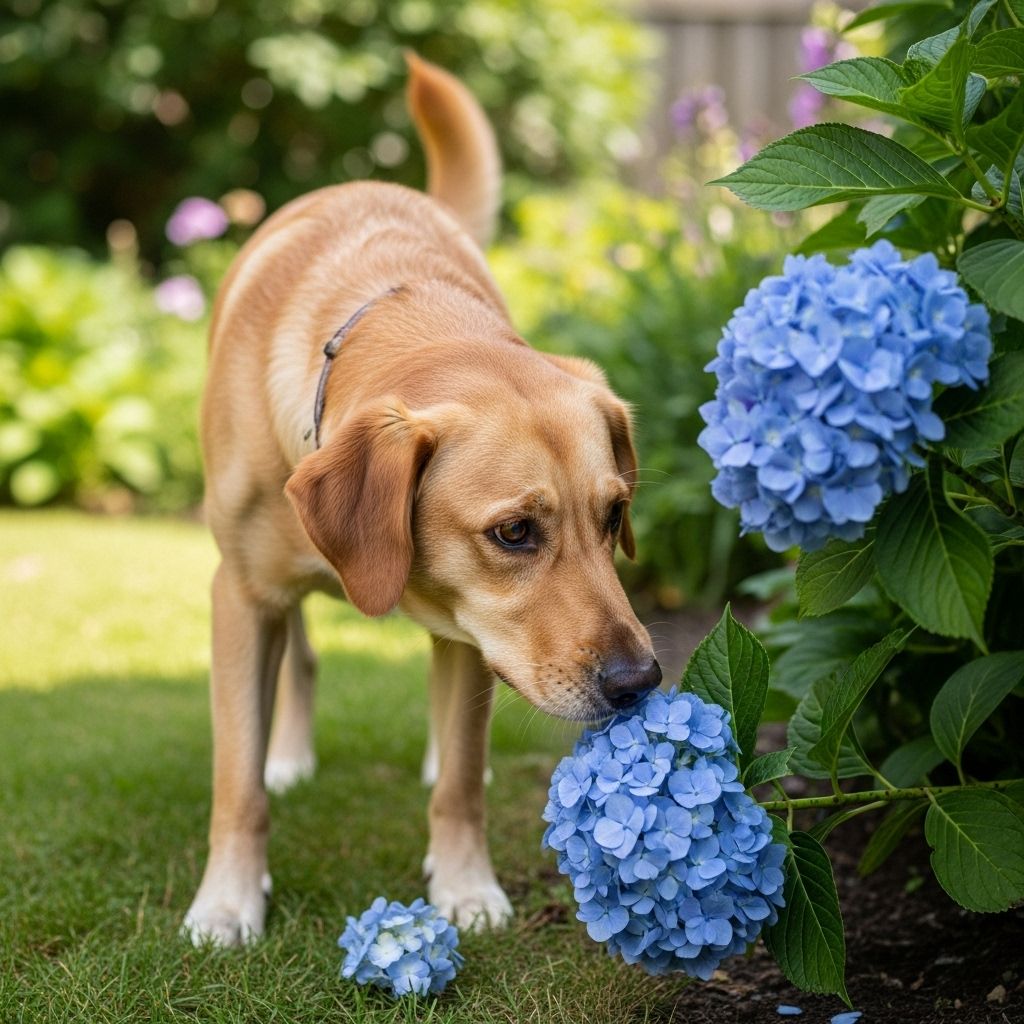Are Hydrangeas Poisonous to Dogs? Risks, Symptoms, and Safety Tips
Understand hydrangea toxicity in dogs, symptoms to watch for, and how to keep your pet safe around garden plants.

Are Hydrangeas Poisonous to Dogs?
Hydrangeas, prized for their beautiful flowers and found in many home gardens, pose a harmful risk to dogs and other pets. These common ornamental plants contain toxins that, when ingested, can lead to a range of symptoms—from mild digestive upset to severe health challenges. Understanding the dangers and knowing the right response could be critical for your pet’s health.
Why Are Hydrangeas Toxic?
Hydrangeas contain cyanogenic glycosides, a compound that, once ingested by dogs, can break down in the digestive tract and release cyanide in small amounts. The toxins are present in all parts of the plant, but are especially concentrated in the leaves and flowers.
- Toxic compound: Cyanogenic glycoside (primarily in leaves and flowers).
- Poisonous to: Dogs, cats, and horses.
- Common names: Hortensia, Hills of Snow, Seven Bark.
How Much Hydrangea Is Dangerous for Dogs?
Any amount of hydrangea can potentially harm a dog, especially those of smaller size. Toxicity is dose-dependent—the more plant material consumed, the higher the risk and severity of symptoms. For a small dog, ingestion of only a few mouthfuls can quickly precipitate clinical signs, whereas larger dogs may require greater amounts. Nevertheless, there is no precise safe threshold; caution is always warranted.
Symptoms of Hydrangea Poisoning in Dogs
Most cases of hydrangea poisoning in dogs are mild to moderate, but severe reactions can occur. Signs typically manifest within a few hours after ingestion and can vary in intensity depending on the amount consumed.
| Severity | Symptoms |
|---|---|
| Mild |
|
| Moderate to Severe |
|
Note: Cyanide intoxication (true cyanide poisoning) is exceedingly rare in dogs but may result in more serious clinical disturbance in exceptional cases.
Steps to Take if Your Dog Eats Hydrangeas
- Remove plant material: Take away any hydrangea remnants from your dog’s surroundings and gently clear remnants from their mouth if possible.
- Monitor your dog: Watch for any changes in behavior, appetite, energy level, vomiting, or diarrhea for at least 24 hours.
- Contact a veterinarian: Call your veterinarian immediately, even if symptoms are mild. Early intervention improves outcomes.
- Provide detailed information: Note when ingestion occurred, how much and what part was consumed, and take a picture of the plant for identification.
- Prepare for transport: If instructed to visit the clinic, keep your dog calm in a secure carrier or on a lead. Monitor their condition en route.
Veterinary Diagnosis and Treatment
Your veterinarian may ask about:
- Time and quantity of ingestion
- Symptoms observed
- Type of hydrangea (picture for verification may help)
Treatment typically involves:
- Induced vomiting (if appropriate and only under veterinary care)
- Administration of activated charcoal to bind toxins
- Supportive care: Intravenous fluids, anti-nausea medications, and monitoring for complications
Early medical intervention is essential for optimal recovery. Do not try to induce vomiting or treat poisoning at home unless instructed by a veterinarian.
Preventing Hydrangea Poisoning
Prevention is always better than urgent care. To protect your dog from plant toxicity, consider these safety practices:
- Pet-proof your garden: Avoid planting hydrangeas, or fence off areas where they grow.
- Supervise outdoor time: Keep dogs under supervision during walks or garden play.
- Educate family and visitors: Make others aware of garden risks for pets.
- Train your dog: Teach a strong “leave it” command to help avoid risky chewing behaviors.
Hydrangeas Compared to Other Toxic Garden Plants
| Plant | Toxic Principle | Symptoms in Dogs |
|---|---|---|
| Hydrangea | Cyanogenic glycoside | Vomiting, diarrhea, lethargy, depression |
| Lilies | Various toxins | Vomiting, drooling, kidney failure |
| Oleander | Cardiac glycosides | Vomiting, heart arrhythmia, death |
| Azaleas/Rhododendrons | Grayanotoxins | Vomiting, drooling, lethargy, heart problems |
| Daffodils | Lycorine | Vomiting, abdominal pain |
Prognosis and Recovery
Prognosis is generally good for dogs with mild hydrangea poisoning when treated early and appropriately. Most recover fully within 24 to 48 hours with symptomatic care. Severe cases—often associated with larger ingestions—may require more intensive support and a longer recovery period. Quick action and professional guidance are essential for the best outcome.
- Mild cases usually resolve with supportive care within a day.
- Severe cases may require hospitalization and intravenous therapy.
- Long-term complications are unlikely but may occur with massive ingestion or delayed treatment.
Frequently Asked Questions (FAQs) About Hydrangea Poisoning in Dogs
Q: Are hydrangeas poisonous to all dog breeds?
A: Yes. Hydrangeas are toxic to all breeds, but symptoms may appear more quickly in smaller dogs due to lower body mass.
Q: How soon do symptoms appear after my dog eats hydrangea?
A: Symptoms often develop within several hours of ingestion but may be delayed up to 24 hours in rare cases.
Q: What should I do if my dog ate hydrangeas but seems fine?
A: Monitor closely for at least 24 hours. Some symptoms can be delayed. Contact your vet immediately if any signs of toxicity appear.
Q: Can hydrangea poisoning result in death?
A: Death is extremely rare and typically associated with massive ingestion or delayed access to veterinary care. Most cases are mild and recover fully with timely treatment.
Q: What does a vet do for hydrangea poisoning?
A: Treatment focuses on removing toxins (induced vomiting, activated charcoal), managing symptoms, and supportive care (fluids, anti-vomiting medications). Severe cases may need hospitalization.
Q: Are other garden plants also dangerous for dogs?
A: Yes. Many popular garden plants are toxic (e.g., lilies, azaleas, oleander, daffodils). Always check for pet safety before landscaping.
Key Takeaways
- Hydrangeas are toxic to dogs. The highest concentration of toxin is in leaves and flowers.
- Symptoms range from mild vomiting to severe lethargy or collapse. Quick action is best.
- Contact your veterinarian immediately if you suspect ingestion. Never wait for symptoms to worsen.
- Prevent hydrangea poisoning by pet-proofing your garden and supervising your dog outdoors.
The information provided in this article is for educational purposes and does not replace veterinary diagnosis or care. If you suspect your dog has ingested any part of a hydrangea or is displaying symptoms, contact a veterinary professional immediately.
References
- https://gsvs.org/blog/hydrangea-poisoning-dogs-immediate-steps/
- https://www.petmd.com/cat/poisons/are-hydrangeas-poisonous-to-cats
- https://www.aspca.org/pet-care/aspca-poison-control/toxic-and-non-toxic-plants/hydrangea
- https://www.petmd.com/poisoning/fall-toxins-poisonous-to-pets
- https://www.wetherbyvets.co.uk/news/109-the-top-12-most-poisonous-plants-for-pets
Read full bio of medha deb












